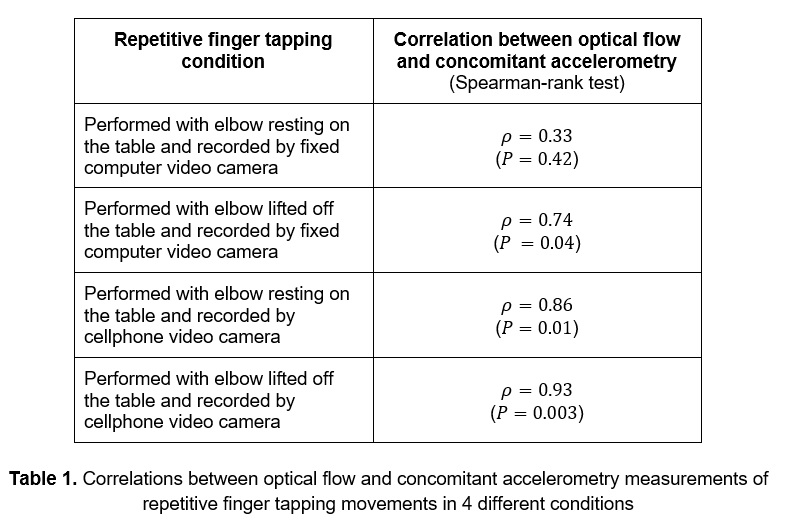Category: Technology
Objective: To optimize optical flow (OF) measurement of repetitive finger tapping movements with the use of concomitant accelerometry in healthy volunteers.
Background: Repetitive finger tapping movements are sensitive to detect bradykinesia. Previous studies using accelerometry to measure finger tapping frequency and amplitude have shown significant differences between people with Parkinson’s disease (PD) and controls. Similarly, computer vision techniques based on OF analysis of video recordings can measure frequency and amplitude of finger tapping movements. Prior studies have used concomitant accelerometry to optimize tremor frequency analysis in patients with PD.
Method: After placing an IMU sensor on the middle phalanx of their index finger (with its axis aligned vertically and perpendicular to the finger), 8 adult volunteers (mean age ± SD = 39.2 ± 25.4 years, range = 20–79) performed repetitive finger tapping movements according to item 3.4 of the Movement Disorders Sponsored Unified PD Rating Scale. On separate occasions, finger tapping movements were performed with the elbow resting on a table and after lifting the elbow off the table. For 4 volunteers, movements were recorded by a fixed computer video camera. For the other 4 volunteers, movements were recorded by a cellphone video camera. Videos were resized to 360x240px resolution. Fourier frequency analysis of accelerometer data and OF data from video recordings were correlated for all conditions using Spearman-rank test.
Results: Overall, there was a positive correlation between OF and accelerometry (ρ=0.69, P=0.00001). Table 1 summarizes the correlations between OF and accelerometry for each condition. The strongest correlation was evidenced for recordings obtained by the cellphone video camera while lifting the elbow off the table (ρ=0.93, P=0.003). The weakest correlation was evidenced for recordings obtained by the fixed computer video camera while the elbow was resting on the table (ρ=0.33, P=0.42).
Conclusion: Compared to concomitant accelerometry, OF accurately measured the frequency of repetitive finger tapping movements in healthy volunteers. Future studies will elucidate why mobile video cameras obtained more accurate information than fixed computer video cameras. Future studies will also compare measurements of movement amplitude in healthy controls and patients with PD.
References: 1. Stamatakis J, Ambroise J, Cremers J, Sharei H, Delvaux V, Macq B, Garraux G. Finger tapping clinimetric score prediction in Parkinson’s disease using low-cost accelerometers. Comput Intell Neurosci. 2013; 2013:717853. 2. Langevin R, Ali MR, Sen T, Snyder C, Myers T, Dorsey ER, Hoque ME. The PARK framework for automated analysis of Parkinson’s disease characteristics. Proceedings of the ACM on Interactive, Mobile, Wearable and Ubiquitous Technologies. 2019; 3(2):1–22.
To cite this abstract in AMA style:
K. Zumaeta, E. Torres, L. Urdiales, A. Ramirez, I. Camargo, B. Castaneda, S. Romero, K. Lizarraga. Accelerometry to optimize optical flow measurement of repetitive finger tapping movements: A pilot study [abstract]. Mov Disord. 2021; 36 (suppl 1). https://www.mdsabstracts.org/abstract/accelerometry-to-optimize-optical-flow-measurement-of-repetitive-finger-tapping-movements-a-pilot-study/. Accessed July 18, 2025.« Back to MDS Virtual Congress 2021
MDS Abstracts - https://www.mdsabstracts.org/abstract/accelerometry-to-optimize-optical-flow-measurement-of-repetitive-finger-tapping-movements-a-pilot-study/

